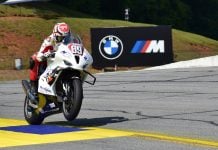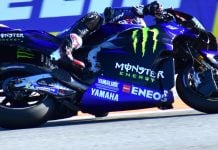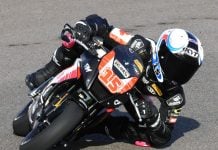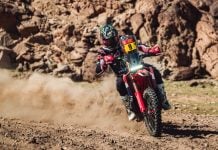2. TECHNICAL REGULATIONS (TO BE APPLIED AS FROM 01.01.2008) 2.1 INTRODUCTION 2.2 CLASSES 2.3 GENERAL ITEMS 2.3.3 Handlebars 2.3.4 Control levers 2.3.5 Wheel and rims (See Table 1) 2.3.6 Tyres 2.3.8 Adaptation of the tyre’s surface 2.3.9 The use of tyre warmers is allowed. 2.3.10 Use of Tyres The competitors shall only use tyres distributed by the Official Supplier during the event. For each event, all tyres must be made of the same quality and shall be strictly identical. All tyres to be used must be easily identifiable with a colour marking or a numerical system, to be applied by the Official Supplier at the time of manufacturing. The Official Supplier shall provide the Superbike Technical Director a written description of the markings and the general characteristics of the different types of tyres. After the tyre samples have been delivered to the Superbike Technical Director the day prior to the start of the official practice, any modification of the tread pattern (with the exception of normal wear) is not permitted. During free practices, qualifying practices, (Superpole for Superbike), warm up session (and race for Superstock), no motorcycle may enter the track without the front and rear tyres being marked (see also Art. 2.4.6.7/ 2.5.6.7/ 2.7.6.7). The Superbike Technical Director may, at his discretion, require the exchange of one (1) or more competitors’ tyres for a tyre sample under his control. The tyres exchanged remain under his control and he can exchange them for the ones of another competitor. An appropriate identification will be applied on the left side of each tyre. No tyres marked for one event may be used during another event. When indicated (see Art. 2.4.6.7/ 2.5.6.7/ 2.7.6.7), no unmarked dry-weather tyres are allowed in the pits. 2.3.11 Ballast The ballast must be made from solid metallic piece/s, firmly, securely connected, either through an adapter or directly to the main frame or engine, with minimum 2 steel bolts (min. 8 mm diameter, 8.8 grade or over). Fuel in the fuel tank can be used as ballast. Nevertheless, the verified weight may never fall below the required minimum weight. 2.4 SUPERBIKE TECHNICAL SPECIFICATIONS Rules intended to give freedom to modify or replace some parts in the interest of safety. EVERYTHING THAT IS NOT AUTHORISED AND PRESCRIBED IN THIS RULE IS STRICTLY FORBIDDEN. Superbike motorcycles require an FIM homologation (see Art. 2.9). All motorcycles must comply in every respect with all the requirements for road racing as specified in the Technical Regulations, unless it is equipped as such on the homologated machine. The appearance from both front, rear and the profile of Superbike motorcycles must (except when otherwise stated) conform in principle to the homologated shape (as originally produced by the manufacturer). The appearance of the exhaust system is excluded from this rule. 2.4.1 Engine configurations and displacement capacities The following Engine configurations compose the Superbike class. Homologation Year, Homologation valid for, Engine configuration and displacements, Minimum weight, Diameter of restrictor Until 2006, 5 years, Over 750 cc up to (included) 1000 cc 2 cylinders ** (1000 cc 2 cylinders), 162 kg, n/a (*) As from 2006, 5 years, Over 750 cc up to 1000 cc 3- cylinders and 1000 cc 4 cylinders **(1000 cc 3 & 4 cylinders), 162 kg, n/a (*) As from 2008, 5 years, Over 850 cc up to 1200cc 2 cylinders **(1200 cc 2 cylinders), 168 kg, 50 mm (*) n/a = not applicable (**) Reference used in the Articles hereunder The displacement capacities must remain at the homologated size. Modifying the bore and stroke to reach class limits is not allowed. 2.4.2 Balancing various motorcycle concepts In order to equalize the performance of motorcycles with different engine configurations, changes in the minimum weight and air restrictor sizes are applied according to their respective racing performances. These handicaps are applied only to the ‘1200 cc 2 cylinder’ machines homologated as from 01.01.2008. At first, a weight handicap is applied according to the relevant provisions in Art. 2.4.2.2. The minimum weight may be reduced twice by 3 kg to a maximum reduction of 6 kg, or increased once and by 3 kg maximum. If this measure proves to be insufficient, then a second handicap will be applied: the size of the intake ports will be changed by means of air restrictors. These changes to the size of the air restrictor diameter will be applied in 2 mm steps, according to the relevant provisions described in Art. 2.4.4.3. 2.4.2.1 Minimum Weights The minimum weight will be: 1000 cc 2- cylinders 162 kg 1000 cc 3 & 1000 cc 4 cylinders 162 kg 1200 cc 2 cylinders 168 kg (**) (**) See handicap rule for further information. During the final inspection at the end of each race, the machines chosen will be weighed in the condition they finished the race. The established weight limit must be met in the condition the machine has finished the race; nothing can be added to the machine. This includes water, oil, or fuel. During the practice and qualifying sessions, riders may be asked to submit their motorcycle to a weight control. In all cases, the rider must comply with this request. At any time of the event, the weight of the whole machine (including the tank and its contents) must not be less than the minimum weight with a tolerance of 1 kg. The use of ballast is allowed to stay over the minimum weight limit and may be required due to a handicap system. The use of ballast and weight handicap must be declared to the Superbike Technical Director at the preliminary checks. 2.4.2.2 Minimum weight adjustments The minimum weights will be increased or decreased in steps of 3 kg according to the following procedure: 1. By taking the race points of the riders of the best two 1000 cc 4 cylinders and best two 1200 cc 2 cylinders in each race an average will be calculated after every event, the ‘event average’. If there is only one finisher from one of the configurations, the ‘event average’ will be calculated from the first rider of each configuration in each race. No ‘event average’ points will be calculated if one of the configurations has no finishers. The ‘event average’ will then be calculated, based on the results of the other race from the same event. If neither race has any finishers from one of the configurations, the event will not be considered. 2. ‘Wet’ races (as declared by the Race Director) are not taken in account for the calculation of an ‘event average’. 3. After 3 events, the average value of the ‘event averages’ of each configuration will be calculated. The score of the 1000 cc 4 cylinders and the score of the 1200 cc 2 cylinders will be compared as follows: · Should the average value of the ‘event averages’ over 3 events favour the 1200 cc 2 cylinders by more than 5 points, and if a rider of a machine with this configuration is leading the riders’ Superbike World Championship standings at that time, then the minimum weight of all 1200 cc 2 cylinders will be increased by 3kg. The upper limit is 171 kg. · Should average value of the ‘event averages’ over 3 events favour the 1000 cc 4 cylinders by more than 5 points, and if a rider of a machine with this configuration is leading the riders’ Superbike World Championship standings at that time, then the minimum weight of all 1200 cc 2 cylinders will be reduced by 3 kg. The lower limit is 162 kg. If the minimum weight is not updated, then the results of three more events will be considered, and a new average value of the ‘event averages’ will be calculated over six events and so on, over multiples of three events, until the points gap of the average value of the ‘event averages’ from the last minimum weight update is higher than 5. The Superbike Technical Director will inform all the teams about the possible minimum weight adjustments, within 24 hours from the end of the last event (the last meeting of the International Jury) where the average value of the ‘event averages’ was calculated. The new minimum weight adjustments must be applied from the first following event. 2.4.2 Carburation Instruments 2.4.4.1 For 1000 cc 2 cylinders · Carburation instruments refer to both throttle bodies and carburettors. · Carburation instruments must be used un-modified either as the original homologated carburation instrument or as the homologated optional carburation instrument. · The only modifications allowed to the homologated carburation instruments original or optional are jets, needles, throttle valves, fuel injectors and bell mouths. · Variable-length carburettor/fuel injection intake tract devices that function while the engine is operating are prohibited, unless such a system is used on the homologated machine · The original manufacturer must use the following criteria for the designing and making of the optional homologated carburation instruments. a) There is no limit for the intake size of an engine equipped either by carburettors or fuel injection systems. b) The optional carburettor / injector body material must remain the same as used on the original homologated carburation instruments. c) A minimum number of optional carburation instruments must be available as spare parts and be included in the manufacturer’s racing parts lists. All manufacturers must have a minimum of 15 sets available through traditional distributorships worldwide for the life of the homologation. The price of the optional carburation instruments to the public must not exceed twice the manufacturers suggested retail price of the original homologated carburation instrument in the country of origin. This price must be indicated on the Homologation Form. d) The motorcycle manufacturer may submit only one optional carburation instrument for each model at the time of homologation. e) The motorcycle manufacturer must supply a sample set of the original and optional carburation instruments to the FIM for use as comparison samples at the events. f) The motorcycle manufacturer must provide evidence that the minimum of 15 sets of optional carburation instruments have been manufactured. g) The optional carburation instruments must be available for at least three years after the homologation date. h) The carburation instrument homologation will be valid for the same period as the homologated motorcycle. i) An additional model of optional carburation instruments may be homologated during the life of the machine’s homologation. These carburation instruments must meet the same requirements as the original modified instruments. This is to allow development after the original homologation. · The optional carburation instruments may only be homologated at the same time as a new homologation. [see number i) above for additional optional carburation instruments] 2.4.4.2 For 1000 cc 3 & 4 cylinders and 1200 cc 2 cylinders · Carburation instruments refer to both throttle bodies and carburettors. · The original homologated carburation instruments must be used un-modified. · The use of optional homologated carburation instruments is not allowed. · The fuel injectors may be replaced, however they must fit without modification to the homologated throttle body. · The carburation instruments intake insulators may be modified. · Bell mouths may be altered or replaced. · Variable length intake tract devices that function while the engine is operating are not allowed, unless such a system is use on the homologated machine. · Vacuum slides may be fixed in the open position · Secondary throttle valves and shafts may be removed or fixed in the open position and the electronics may be disconnected or removed 2.4.4.3 Air restrictors for 1200 cc 2- cylinders Definition: An air restrictor is a metallic device with precisely 3 mm (+/-0.1 mm) of constant controlled section and which is placed in the induction tract after the carburation instrument (throttle body). No air and/or air-fuel mixture to the engine must by-pass the restrictor. No carburation part (injector, needle, slide, etc) must extend through the restrictor. Application: Only the 1200 cc 2 cylinders will be fitted with air restrictors. The initial air restrictor size to be installed is equivalent to a Ø 50 mm circular area (1963,5 mm2). Air restrictor size will be adjusted (in steps equivalent to a change of 2 mm in diameter or equivalent circular area, upwards to Ø 52 mm and then to no restrictor at all, downwards to a minimum of Ø 46 mm), if needed during the Championship, as described below in Art. 2.4.4.4. The Manufacturer must supply the FIM with 20 sets of plug-calibres (-gauges) to check the diameter of the air restrictor when using one of the prescribed sizes (Ø 52, Ø 50, Ø 48, Ø 46 mm). A Manufacturer may have a non-circular air restrictor, provided that the area of this restrictor is equivalent to the area of a nominal circular restrictor. In this case, the Manufacturer must supply the FIM with 20 sets of plug-calibres (- gauges) for measuring the restrictor during the technical verifications. The FIM may also request the Manufacturer to supply a cut section of the air restrictor(s) in each of the prescribed sizes. 2.4.4.4 Air Restrictor adjustment The minimum air restrictor size is increased or decreased in 2 mm steps in diameter of equivalent circular area, according to following procedure: 1. – If the minimum weight of the 1200 cc 2 cylinders configuration has reached the lower limit of 162 kg and, – if the resulting gap in the average value of ‘event averages’ is more than 5 points in favour of the 1000 cc 4- cylinders and, – if a rider of a 1000 cc 4 cylinder is leading the riders’ Superbike World Championship standings at that time, then the initial air restrictor size of the 1200 cc 2 cylinders will be increased by one size, to a Ø 52 mm (or the equivalent area 2123.7 mm2), or as a last step, without any air restrictor. 2. – If the minimum weight for 1200 cc 2 cylinder configuration has reached the upper limit of 171 kg and, – if the resulting gap of the average value of ‘event averages’ is more than 5 points in favour of the 1200 cc 2 cylinders and, – if a rider of a 1200 cc 2 cylinder is leading the riders’ Superbike World Championship standings at that time, then the initial air restrictor size of the 1200 cc 2 cylinders will be reduced by one size, to a Ø48 mm (or the equivalent area 1809,6 mm2), or, as last step, to a minimum of Ø46 mm (or the equivalent area 1661.9 mm2). If the air restrictor size is not updated, then the results of three more events will be considered, and a new average value of the ‘event averages’ will be calculated over six events and so on, over multiples of three events, until the points gap of the average value of the ‘event averages’ from the last air restrictor size update is higher than 5. The Superbike Technical Director will inform all the teams about the possible air restrictor size adjustments, within 24 hours from the end of the last event (the last meeting of the International Jury), where the average value of the ‘event averages’ was calculated. The new air restrictor size adjustments must be applied as from the first following event. 2.4.5 Fuel 2.4.6 Machine Specifications (From Art. 2.4.2.1, to be added, other text remains unchanged): The use of titanium in the construction of the front forks, the handlebars and the swingarm spindle is forbidden. 2.4.6.1 Frame Body and Rear Sub-Frame 2.4.6.2 Front Forks 2.4.6.3 Rear Fork (swing-arm) 2.4.6.4 Rear Suspension Unit 2.4.6.5 Wheels The use of titanium and light alloys is forbidden for wheel spindles (axles). 2.4.6.6 Brakes 2.4.6.7 Tyres 2.4.6.8 Foot Rest/Foot Controls 2.4.6.9 Handle Bars and Hand Controls 2.4.6.10 Fairing/Body Work & Number Plate Colours 2.4.6.11 Fuel Tank 2.4.6.12 Seat 2.4.6.13 Radiator/Oil Cooler 2.4.6.14 Air Box The air box may be altered or replaced from those fitted to the homologated motorcycle (a special design for racing is allowed). If fuel injectors are attached to the cover of the air box, their position must remain as original. The air filter element may be removed. The air box must be completely closed around the induction bell mouth and all engine breather tubes. Carburation instruments may be entirely within the airbox. The air box drains must be sealed. All motorcycles must have a closed breather system. The oil breather line must be connected and discharge in the airbox. The breather system (airbox plus any breather oil collector box) must be capable in the event of drain pipe blockage, of retaining a minimum of 1000 cc of discharged fluid. 2.4.6.17 Fuel Supply ECU can be modified or changed. Fuel pump and pressure regulator may be modified or changed. Fuel lines may be replaced. The fuel line(s) going from the fuel tank to the carburation instruments must be located in such a way that they are protected from possible defects. Fuel vent lines may be replaced. Fuel filters may be added. Fuel petcock may be altered or replaced from those fitted to the homologated motorcycle. 2.4.6.18 Engine The following engine components may not be altered from the homologated machine except as noted. The homologated engine design model cannot be changed. Homologated materials and castings for the crankcase, cylinder, cylinder head and gear-box housing must be used. Material for the crankcase, cylinder, cylinder head and gear-box housing may only be added by welding or removed by machining. The method of cam drive must remain as homologated unless a complete kit is available through normal commercial channels. These kits must be available in significant quantity and be listed in the racing spare parts book. · For 1000 cc 3 & 4 cylinders and 1200 cc 2 cylinders Aftermarket or modified cam drive components are allowed, however the cam drive must be in the homologated location. The method of valve retention must remain as the homologated model (no pneumatic valve retention devices are allowed unless fitted to the homologated model). All moving internal engine, gear-box and clutch parts may be altered or replaced including materials from those fitted on the homologated motorcycle (unless not allowed by the individual section covering the parts in question). Polishing and lightening of engine parts is permitted, except for carburation instruments (unless not allowed by the individual section covering the parts in question). · For all configurations The sequence in which the cylinders are ignited (i.e. 1-2-4-3), must remain as originally designed on the homologated model. Simultaneous (*) firing of 2 cylinders is also forbidden if not adopted on the homologated motorcycle. *up to 5 degrees firing difference in 2 cylinders is regarded as ‘simultaneous’ firing. 2.4.6.19 Cylinder Head The homologated cylinder head can be modified as follows: Homologated materials and castings for the cylinder heads must be used. Material for these parts may only be added by welding or removed by machining. The induction and exhaust system including the number of valves and or ports (intake and exhaust) must be as homologated. Porting and polishing of the cylinder head normally associated with individual tuning such as gas flowing of the cylinder head, including the combustion chamber is allowed. The compression ratio is free. The combustion chamber may be modified. The valves may be altered or replaced from those fitted to the homologated motorcycle. The valve seats may be altered or replaced from those fitted to the homologated motorcycle. The valve guide may be altered or replaced from those fitted to the homologated motorcycle. Valve springs may be altered or replaced from those fitted to the homologated motorcycle. The valve retainers may be altered or replaced from those fitted to the homologated motorcycle. · For 1000 cc 3 & 4 cylinders and 1200 cc 2 cylinders Aftermarket or modified valves, springs, retainers and other valve train components are permitted. The original number of valves must be maintained. a. Valve diameters, including stem, must remain as homologated. b. Valves must be made of the same basic material as the homologated valves. c. Valves must remain in the homologated location and at the same angle as the homologated valves, except for normal valve maintenance. d. Rocker arms (if any) must remain as homologated (material and dimensions). 2.4.6.20 Camshaft 2.4.6.21 Cam Sprockets or Gears 2.4.6.22 Crankshaft · For 1000 cc 2 cylinders Crankshaft may be altered or replaced from those fitted to the homologated motorcycle. Crankshaft stroke must remain as homologated. · For 1000 cc 3 & 4 cylinders and 1200cc 2 cylinders The following modifications are allowed to the homologated crankshaft: a. Bearing surfaces may be polished or a surface treatment may be applied. b. Balancing is allowed but only by the same method as the homologated crankshaft. (for example heavy metal i.e. Mallory metal inserts are not permitted unless they are originally specified in the homologated crankshaft.) c. Attachment of aftermarket ignition components or sensors is permitted. d. Balance shaft may be removed. 2.4.6.23 Oil Pumps and Oil Lines 2.4.6.24 Connecting Rods · For 1000 cc 2 cylinders and 1000 cc 3 & 4 cylinders Connecting rod may be altered or replaced from those fitted to the homologated motorcycle. Carbon composite or carbon fibre materials are not allowed if not used in the homologated motorcycle. · For 1200 cc 2 cylinders Connecting rod must remain as homologated. Polishing and lightening is not allowed. 2.4.6.25 Pistons · For 1000cc 2 cylinders, 1000 cc 3 & 4 cylinders Pistons may be altered or replaced from those fitted to the homologated motorcycle. · For 1200 cc 2 cylinders Standard piston or the kit (*) piston must be used. (*) The kit piston must have the same price as the standard one and must be listed in the current racing parts list of the Manufacturer and be on sale for customers. Within 90 days from the order, the customer must receive the kit piston set. 2.4.6.26 Piston Rings 2.4.6.27 Piston Pins and Clips 2.4.6.28 Cylinders 2.4.6.29 Crankcase/Gearbox housing and lateral covers 2.4.6.30 Transmission/Gearbox All transmission/gearbox ratios, shafts, drums, selector forks are free. Primary gear ratios are free. The number of gears must remain as homologated. Additions to gearbox or selector mechanism, such as quick shift systems, are allowed. Countershaft sprocket, rear wheel sprocket, chain pitch and size can be changed. 2.4.6.31 Clutch Aftermarket or modified clutches are permitted. Back torque limiter is permitted. · For 1000 cc 2 cylinders Clutch system (wet or dry type) and method of operation (cable/hydraulic) may be altered or replaced from those fitted to the homologated motorcycle. · For 1000 cc 3 & 4 cylinders and 1200cc 2 cylinders Clutch system (wet or dry type) and method of operation (cable/hydraulic) must remain as homologated. 2.4.6.32 Ignition/Engine Control System 2.4.6.33 Generator, alternator, electric starter 2.4.6.34 Exhaust System 2.4.7 The Following items MAY BE altered or replaced from those fitted to the homologated motorcycle. 2.4.8 The Following items MAY BE removed 2.4.9 The Following Items MUST BE Removed 2.4.10 The Following items MUST BE altered 2.4.11 Additional Equipment
Details On The Changes To The Superbike World Championship Technical Rules For 2008
Details On The Changes To The Superbike World Championship Technical Rules For 2008
© 2007, Roadracing World Publishing, Inc.






